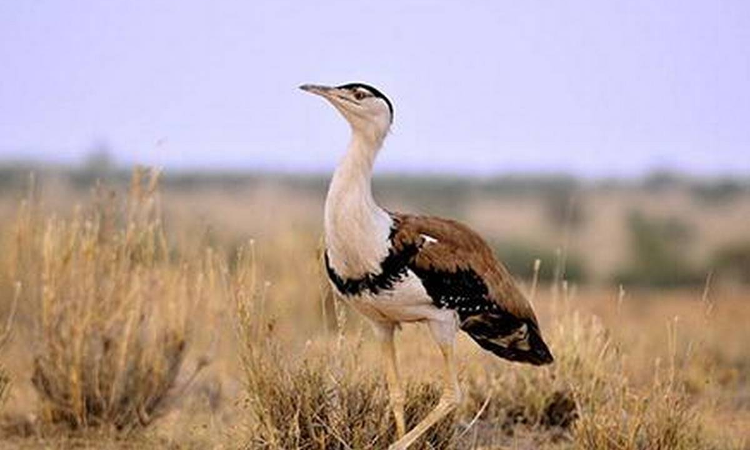- Home
- /
- Environment
- /
- What Steps Are Being Taken To...
What Steps Are Being Taken To Protect Great Indian Bustard? Karnataka High Court Asks State Govt
Mustafa Plumber
7 Dec 2020 3:12 PM GMT
The Karnataka High Court, recently issued notice to the state government and directed it to place on record the immediate steps it proposes to take for protecting, surviving bird species of the Great Indian Bustard, in the state. A division bench of Chief Justice Abhay Oka and Justice S Vishwajith Shetty gave the direction while hearing a petition filed by conversationalist Edward...
The Karnataka High Court, recently issued notice to the state government and directed it to place on record the immediate steps it proposes to take for protecting, surviving bird species of the Great Indian Bustard, in the state.
A division bench of Chief Justice Abhay Oka and Justice S Vishwajith Shetty gave the direction while hearing a petition filed by conversationalist Edward Santosh Martin and others.
The bench said "The Wildlife Protection Act has been enacted to provide for protection of wild animals, birds and plants. The definition of animal includes birds and the definition of wildlife includes animals which include birds. Thus, it is the obligation of the state to protect the wildlife." It added that "Under Article 48A of the Constitution state will have to protect, improve and safeguard forest and wildlife." The government has to respond on December 21.
The petition states the illegal actions of respondents, undertaking civil works such as construction of watch towers and anti-poaching camps, within the area of habitat of the species has pushed the species to the brink of extinction which is a blatant violation of Part III, Schedule I of the Wild Life(Protection) Act, 1972.
It is stated that GIB is a bird with an average age of about 12-15 years. Studies have shown that it lays about one egg every one to two years. In case of a drought, the bird may lay no eggs at all. Under ideal circumstances, the bustard chicks hatched have a survival rate of 60-70%.
Around the time of Independence, the GIB was found throughout Western India, spanning eleven states, including Rajasthan, (across the border shared with Pakistan), Haryana, Madhya Pradesh, Maharashtra, Andhra Pradesh, Gujarat, and Karnataka. Today, however, the bird has disappeared from over 90% of its traditional habitat. It is now restricted to fragmented pockets with very low populations in Rajasthan, Andhra Pradesh, Kamataka, Maharashtra and Gujarat.
In 2006, after years of exploring, a team of wild life enthusiasts including the Petitioner No 1, discovered about 'nine bustards' in a remote corner of Ballari district, Siruguppain Karnataka. They had documented a few young ones as well, indicating that Karnataka had a breeding population. Since then, the NGO, along with local volunteers and Karnataka Forest Department (KFD), have been monitoring sightings of this species.
The petiton says that recently, as part of CAMPA, JSW Limited had purchased 250 acres of land in Ballari where the GIB was seen, and had handed it over to the KFD towards protection of the bustard. In 2016, a rapid assessment survey by the NGO found 12 GIBs here.
Further, the plea says in May 2020, the KFD began digging hundreds of pits to plant saplings of tall trees in the very same area the GIBs were found. Converting grassland to a tree plantation is not conducive for the GIB.
"The GIB is an open-country bird that avoids areas with dense and tall plants. In addition to this, anti-poaching camps and five watchtowers are being constructed in great haste. These buildings and tall trees will cause hindrance to the birds and cause them to fly away in search of favorable habitats," the plea says.
It is added "The presence of tall structures (such as the ones built now by the Karnataka Forest Department) will adversely impact these low flying birds which have poor frontal vision. GIBs prefer open grasslands without structures and tall trees. Many GIB deaths have been reported in India when these birds hit power lines, tall structures or tall wind power generators because of poor frontal vision. Great Indian Bustards stopped breeding in Karnataka's only GIB Sanctuary, Ranebennur because the Forest Department built tall structures."
The petitioners highlight that the existing constructions will be removed by this winter at the latest so that the GIBs may perhaps breed again in the spring. If they miss the breeding season for the second year at a stretch, their extinction from Karnataka is definite as there are not more than 8 surviving species of GIB in Karnataka.
The petition prayed for following directions.
*Issue a writ of mandamus, directing the Respondents to take immediate measures by preparing and implementing a plan for the protection and preservation of the GIB
*Issue a direction to the Respondents on the immediate ban of all civil works within the habitat of the GIB and removal of existing structures in the habitats of the GIB
*Issue a direction to ban the encroachment of grasslands in and around the habitats of the GIB and adopt a grassland conservation policy on an immediate basis.
*Issue a writ of mandamus to appoint an empowered committee to oversee the implementation of directions issued by this Hon'ble Court to preserve and manage the habitats of the species.
By way of interim relief it has sought directions to be issued to the respondents to immediately ban all civil works and removal of already constructed structures in the habitat of the GIBs, until disposal of petition.Click Here To Download Petition
[Read Petition]


